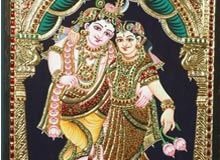 Tanjore Painting is one of the most popular forms of classical South Indian painting. It is the native art form of Thanjavur (also known as Tanjore) city of Tamil Nadu. The dense composition, surface richness and vibrant colors of Indian Thanjavur Paintings distinguish them from the other types of paintings. Then, there are embellishments of semi-precious stones, pearls and glass pieces that further add to their appeal. The relief work gives them a three dimensional effect. Tanjore Painting of India originated during the 16th century, under the reign of the Cholas.
Tanjore Painting is one of the most popular forms of classical South Indian painting. It is the native art form of Thanjavur (also known as Tanjore) city of Tamil Nadu. The dense composition, surface richness and vibrant colors of Indian Thanjavur Paintings distinguish them from the other types of paintings. Then, there are embellishments of semi-precious stones, pearls and glass pieces that further add to their appeal. The relief work gives them a three dimensional effect. Tanjore Painting of India originated during the 16th century, under the reign of the Cholas.Maratha princes, Nayakas, Rajus communities of Tanjore and Trichi and Naidus of Madurai also patronized Indian Thanjavur Paintings from 16th to 18th century. Most of these paintings revolve around
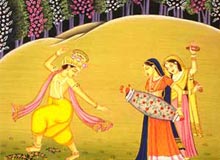 Rajput painting originated in the royal states of Rajasthan, somewhere around the late 16th and early 17th century. The Mughals ruled almost all the princely states of Rajasthan at that time and because of this; most of the schools of Rajput Painting in India reflect strong Mughal influence. Each of the Rajput kingdoms evolved a distinctive style. However, similarities and common features can still be found in the paintings of different territories.
Rajput painting originated in the royal states of Rajasthan, somewhere around the late 16th and early 17th century. The Mughals ruled almost all the princely states of Rajasthan at that time and because of this; most of the schools of Rajput Painting in India reflect strong Mughal influence. Each of the Rajput kingdoms evolved a distinctive style. However, similarities and common features can still be found in the paintings of different territories. 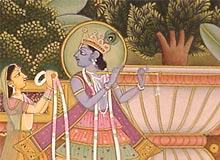 Pahari painting is the name given to Rajput paintings, made in Himachal Pradesh and Jammu & Kashmir states of India. These paintings developed and flourished during the period of 17th to 19th century. Indian Pahari paintings
Pahari painting is the name given to Rajput paintings, made in Himachal Pradesh and Jammu & Kashmir states of India. These paintings developed and flourished during the period of 17th to 19th century. Indian Pahari paintings 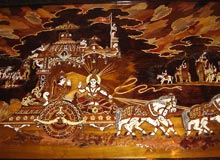 Mysore Painting is a form of classical South Indian painting, which evolved in the Mysore city of Karnataka. During that time, Mysore was under the reign of the Wodeyars and it was under their patronage that this school of painting reached its zenith. Quite similar to the Tanjore Paintings, Mysore Paintings of India make use of thinner gold leaves and require much more hard work. The most popular themes of these paintings include Hindu Gods and Goddesses and scenes from Hindu mythology. The grace, beauty and intricacy of Indian Mysore Paintings leave the onlookers mesmerized.
Mysore Painting is a form of classical South Indian painting, which evolved in the Mysore city of Karnataka. During that time, Mysore was under the reign of the Wodeyars and it was under their patronage that this school of painting reached its zenith. Quite similar to the Tanjore Paintings, Mysore Paintings of India make use of thinner gold leaves and require much more hard work. The most popular themes of these paintings include Hindu Gods and Goddesses and scenes from Hindu mythology. The grace, beauty and intricacy of Indian Mysore Paintings leave the onlookers mesmerized. 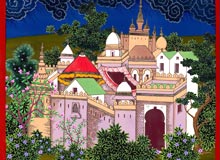 Mughal painting reflects an exclusive combination of Indian, Persian and Islamic styles. As the name suggests, these paintings evolved as well as developed during the rule of Mughal Emperors in India, between 16th to 19th century. The Mughal paintings of India revolved around themes, like battles, court scenes, receptions, legendary stories, hunting scenes, wildlife, portraits, etc. The Victoria and Albert Museums of London house a large and impressive collection of Mughal paintings.
Mughal painting reflects an exclusive combination of Indian, Persian and Islamic styles. As the name suggests, these paintings evolved as well as developed during the rule of Mughal Emperors in India, between 16th to 19th century. The Mughal paintings of India revolved around themes, like battles, court scenes, receptions, legendary stories, hunting scenes, wildlife, portraits, etc. The Victoria and Albert Museums of London house a large and impressive collection of Mughal paintings.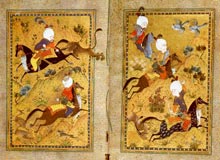 Miniatures paintings are beautiful handmade paintings, which are quite colorful but small in size. The highlight of these paintings is the intricate and delicate brushwork, which lends them a unique identity. The colors are handmade, from minerals, vegetables, precious stones, indigo, conch shells, pure gold and silver. The most common theme of the Miniature painting of India comprises of the Ragas i.e., the musical codes of Indian classical music. There were a
Miniatures paintings are beautiful handmade paintings, which are quite colorful but small in size. The highlight of these paintings is the intricate and delicate brushwork, which lends them a unique identity. The colors are handmade, from minerals, vegetables, precious stones, indigo, conch shells, pure gold and silver. The most common theme of the Miniature painting of India comprises of the Ragas i.e., the musical codes of Indian classical music. There were a 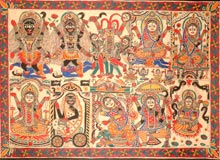 Madhubani painting originated in a small village, known as Maithili, of the
Madhubani painting originated in a small village, known as Maithili, of the